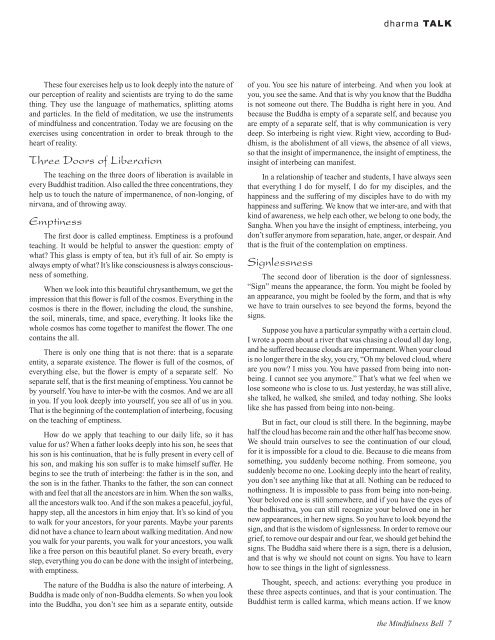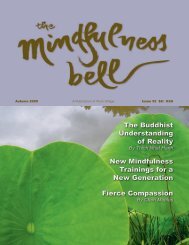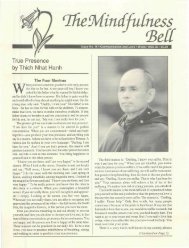Mindfulness and Liberation True Love Global Sangha: - The ...
Mindfulness and Liberation True Love Global Sangha: - The ...
Mindfulness and Liberation True Love Global Sangha: - The ...
- No tags were found...
Create successful ePaper yourself
Turn your PDF publications into a flip-book with our unique Google optimized e-Paper software.
dharma TALK<strong>The</strong>se four exercises help us to look deeply into the nature ofour perception of reality <strong>and</strong> scientists are trying to do the samething. <strong>The</strong>y use the language of mathematics, splitting atoms<strong>and</strong> particles. In the field of meditation, we use the instrumentsof mindfulness <strong>and</strong> concentration. Today we are focusing on theexercises using concentration in order to break through to theheart of reality.Three Doors of <strong>Liberation</strong><strong>The</strong> teaching on the three doors of liberation is available inevery Buddhist tradition. Also called the three concentrations, theyhelp us to touch the nature of impermanence, of non-longing, ofnirvana, <strong>and</strong> of throwing away.Emptiness<strong>The</strong> first door is called emptiness. Emptiness is a profoundteaching. It would be helpful to answer the question: empty ofwhat? This glass is empty of tea, but it’s full of air. So empty isalways empty of what? It’s like consciousness is always consciousnessof something.When we look into this beautiful chrysanthemum, we get theimpression that this flower is full of the cosmos. Everything in thecosmos is there in the flower, including the cloud, the sunshine,the soil, minerals, time, <strong>and</strong> space, everything. It looks like thewhole cosmos has come together to manifest the flower. <strong>The</strong> onecontains the all.<strong>The</strong>re is only one thing that is not there: that is a separateentity, a separate existence. <strong>The</strong> flower is full of the cosmos, ofeverything else, but the flower is empty of a separate self. Noseparate self, that is the first meaning of emptiness. You cannot beby yourself. You have to inter-be with the cosmos. And we are allin you. If you look deeply into yourself, you see all of us in you.That is the beginning of the contemplation of interbeing, focusingon the teaching of emptiness.How do we apply that teaching to our daily life, so it hasvalue for us? When a father looks deeply into his son, he sees thathis son is his continuation, that he is fully present in every cell ofhis son, <strong>and</strong> making his son suffer is to make himself suffer. Hebegins to see the truth of interbeing: the father is in the son, <strong>and</strong>the son is in the father. Thanks to the father, the son can connectwith <strong>and</strong> feel that all the ancestors are in him. When the son walks,all the ancestors walk too. And if the son makes a peaceful, joyful,happy step, all the ancestors in him enjoy that. It’s so kind of youto walk for your ancestors, for your parents. Maybe your parentsdid not have a chance to learn about walking meditation. And nowyou walk for your parents, you walk for your ancestors, you walklike a free person on this beautiful planet. So every breath, everystep, everything you do can be done with the insight of interbeing,with emptiness.<strong>The</strong> nature of the Buddha is also the nature of interbeing. ABuddha is made only of non-Buddha elements. So when you lookinto the Buddha, you don’t see him as a separate entity, outsideof you. You see his nature of interbeing. And when you look atyou, you see the same. And that is why you know that the Buddhais not someone out there. <strong>The</strong> Buddha is right here in you. Andbecause the Buddha is empty of a separate self, <strong>and</strong> because youare empty of a separate self, that is why communication is verydeep. So interbeing is right view. Right view, according to Buddhism,is the abolishment of all views, the absence of all views,so that the insight of impermanence, the insight of emptiness, theinsight of interbeing can manifest.In a relationship of teacher <strong>and</strong> students, I have always seenthat everything I do for myself, I do for my disciples, <strong>and</strong> thehappiness <strong>and</strong> the suffering of my disciples have to do with myhappiness <strong>and</strong> suffering. We know that we inter-are, <strong>and</strong> with thatkind of awareness, we help each other, we belong to one body, the<strong>Sangha</strong>. When you have the insight of emptiness, interbeing, youdon’t suffer anymore from separation, hate, anger, or despair. Andthat is the fruit of the contemplation on emptiness.Signlessness<strong>The</strong> second door of liberation is the door of signlessness.“Sign” means the appearance, the form. You might be fooled byan appearance, you might be fooled by the form, <strong>and</strong> that is whywe have to train ourselves to see beyond the forms, beyond thesigns.Suppose you have a particular sympathy with a certain cloud.I wrote a poem about a river that was chasing a cloud all day long,<strong>and</strong> he suffered because clouds are impermanent. When your cloudis no longer there in the sky, you cry, “Oh my beloved cloud, whereare you now? I miss you. You have passed from being into nonbeing.I cannot see you anymore.” That’s what we feel when welose someone who is close to us. Just yesterday, he was still alive,she talked, he walked, she smiled, <strong>and</strong> today nothing. She lookslike she has passed from being into non-being.But in fact, our cloud is still there. In the beginning, maybehalf the cloud has become rain <strong>and</strong> the other half has become snow.We should train ourselves to see the continuation of our cloud,for it is impossible for a cloud to die. Because to die means fromsomething, you suddenly become nothing. From someone, yousuddenly become no one. Looking deeply into the heart of reality,you don’t see anything like that at all. Nothing can be reduced tonothingness. It is impossible to pass from being into non-being.Your beloved one is still somewhere, <strong>and</strong> if you have the eyes ofthe bodhisattva, you can still recognize your beloved one in hernew appearances, in her new signs. So you have to look beyond thesign, <strong>and</strong> that is the wisdom of signlessness. In order to remove ourgrief, to remove our despair <strong>and</strong> our fear, we should get behind thesigns. <strong>The</strong> Buddha said where there is a sign, there is a delusion,<strong>and</strong> that is why we should not count on signs. You have to learnhow to see things in the light of signlessness.Thought, speech, <strong>and</strong> actions: everything you produce inthese three aspects continues, <strong>and</strong> that is your continuation. <strong>The</strong>Buddhist term is called karma, which means action. If we knowthe <strong>Mindfulness</strong> Bell 7
















